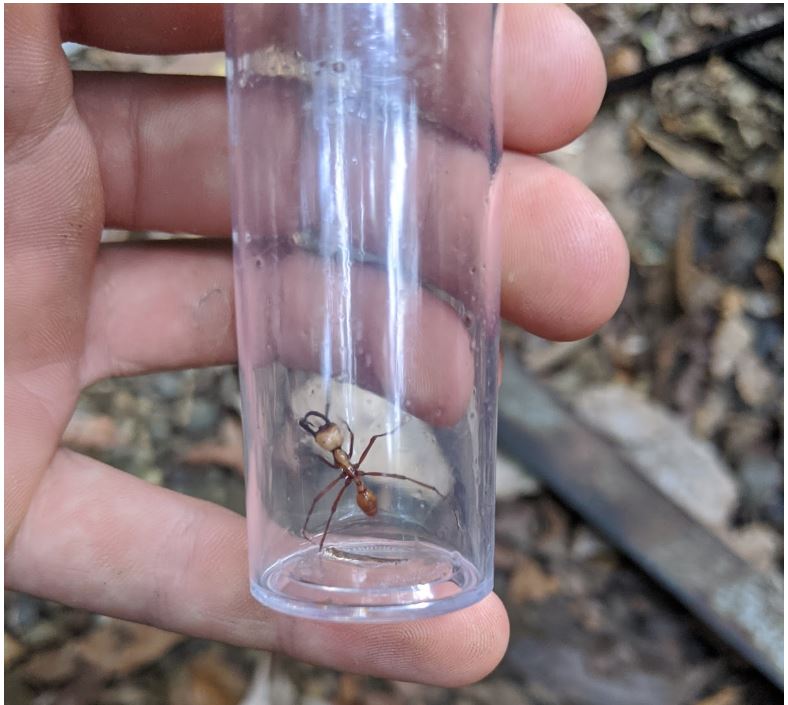In the rainforest of Panama, the interactions between animals are endless. This is exceptionally true when it comes to army ants. Army ants exist over a few genera including Labidus and Eciton. Many army ant species are mostly nocturnal such as Eciton vagans (Powell & Franks 2006), and others forage primarily underground (Kumar & O’Donnell, 2009).
Because of the difficulty of working with nocturnal or subterranean ants we focused on the often (relatively) seen ants: Eciton burchelli and Labidus praedator. These species have a foraging behavior that is unusual compared to other ants. They will fan out over sizable areas (30ft wide and 2 ft deep) to hunt insects and arthropods in the leaf litter. In doing so, they scare their prey, and the insects run away from the ants. Other animals can also take advantage of these fleeing insects.

Some birds, such as the Ocellated antbirds and the Bicolored antbirds, eat these insects. Another, less known group of animals that prey on these insects are parasitoids. Parasitoids are insects whose larvae feed on a single host and eventually kills it. These include many wasps such as ichneumodids, brachonids, and some flies.

I am partly attempting to describe this community of parasitoids around the army ant swarms. This means identifying the various species present and quantifying their abundances. Doing so would help us to better understand the interactions that exist between the army ants, birds, and other insects. I also have questions about the behavior and competition among these communities. What strategies are these parasitoids employing to lay their eggs? Is there competition within a species, between species or both? And if so what are some of the effects of that? Answering these questions will have to happen at a later date.
I am interested in this project because the life cycles of parasitoids are unique compared to most other animals. Also the diversity is astounding there are more species of parasitoid wasps in a single family than there are species of birds in total. However, there is not nearly as much research into them as there is into birds or other large animals.
Most of my time on this project was spent trying to locate the ant swarms. The ant colonies have two main phases, stationary and emigrating. During the stationary phase the colonie stays in the same place every night while the workers go out and capture prey. During the emigrating phase they move their entire colony every day to a new location. This means our best way of searching for the ants is to walk up and down a gravel road and hope that we stumble across a swarm. We can also listen for the attendant birds that are often at the swarm. If we hear their calls, we then search off the trail. We found a total of six swarms, three of which where in the same day.
Collecting the parasitoids is extremely difficult. Part of the struggle of collecting them is the density of underbrush in the forests in Panama. It can be difficult to find a path to walk through the forest, much less swing a bug net.
I did manage to catch some of the slower flies that would often be seen on leaves near the front of the swarms. I stored them in 95 % ethanol in a 1.5 ml vial. This will help me to identify these specimens later when I have access to a microscope and an identification guide book.

This was my first time in the tropics. It made me realize how difficult it could be to work with species like army ants. However it also excited me about all of the animals, plants and interactions that are available to work with.
More reading could be done on a meta analysis done by Quevillon et al. It explains many ants and parasitoid interactions in an easily understandable way.
For more about Ethan’s research and the WyoPanama program, visit the following links: WyoPanama course on Facebook | The UWyo Biodiversity Institute’s spring 2020 series on WyoPanama research | WyoPanama course website
Ethan (Asheville, NC) is a junior majoring in Zoology at the University of Wyoming. He developed and led his own, independent research project as part of the WyoPanama study abroad course supported by the UWyo Honors College and Travel Abroad program. The course is led by Department of Zoology and Physiology faculty Patrick Kelley and Bethann Garramon Merkle, with invaluable support from TA and international master’s student Laura Gomez-Murillo.
